How To Convert and Calculate Units: Top Simple Ways
 |
| How to convert units: Best and simple ways |
With all of the different measuring systems in the world, converting units can come in handy. You'll need to understand fractions, unless you are working with the metric system. These are the best, simple and easy ways to understand, calculate and convert units.
Every field of science involves taking measurements, understanding them, and communicating them to others. In other words, we all have to speak the same basic language. Whether you are a chemist, a physicist, a biologist, an engineer, or even a medical doctor, you need a consistent way of communicating size, mass, shape, temperature, time, amount, energy, power, and speed. This is the best ways to convert and calculate units.
What are Units?
A unit of measurement is a definite magnitude of a quantity, defined and adopted by convention or by law, that is used as a standard for measurement of the same kind of quantity. Any other quantity of that kind can be expressed as a multiple of the unit of measurement. For example, a length is a physical quantity. The metre is a unit of length that represents a definite predetermined length. When we say 10 metres (or 10 m), we actually mean 10 times the definite predetermined length called "metre". Measurement is a process of determining how large or small a physical quantity is as compared to a basic reference quantity of the same kind.
The definition, agreement, and practical use of units of measurement have played a crucial role in human endeavour from early ages up to the present. A multitude of systems of units used to be very common. Now there is a global standard, the International System of Units (SI), the modern form of the metric system.
In trade, weights and measures is often a subject of governmental regulation, to ensure fairness and transparency. The International Bureau of Weights and Measures (BIPM) is tasked with ensuring worldwide uniformity of measurements and their traceability to the International System of Units (SI).
Metrology is the science of developing nationally and internationally accepted units of measurement.
In physics and metrology, units are standards for measurement of physical quantities that need clear definitions to be useful. Reproducibility of experimental results is central to the scientific method. A standard system of units facilitates this. Scientific systems of units are a refinement of the concept of weights and measures historically developed for commercial purposes.
Science, medicine, and engineering often use larger and smaller units of measurement than those used in everyday life. The judicious selection of the units of measurement can aid researchers in problem solving (see, for example, dimensional analysis).
In the social sciences, there are no standard units of measurement and the theory and practice of measurement is studied in psychometrics and the theory of conjoint measurement.
History of Units of Measurement
A unit of measurement is a standardised quantity of a physical property, used as a factor to express occurring quantities of that property. Units of measurement were among the earliest tools invented by humans. Primitive societies needed rudimentary measures for many tasks: constructing dwellings of an appropriate size and shape, fashioning clothing, or bartering food or raw materials.
The earliest known uniform systems of measurement seem to have all been created sometime in the 4th and 3rd millennia BC among the ancient peoples of Mesopotamia, Egypt and the Indus Valley, and perhaps also Elam in Persia as well.
Weights and measures are mentioned in the Bible (Leviticus 19:35–36). It is a commandment to be honest and have fair measures.
In the Magna Carta of 1215 (The Great Charter) with the seal of King John, put before him by the Barons of England, King John agreed in Clause 35 "There shall be one measure of wine throughout our whole realm, and one measure of ale and one measure of corn—namely, the London quart;—and one width of dyed and russet and hauberk cloths—namely, two ells below the selvage..."
What is Metric System?
The metric system of measurement is the standard way of measuring distance, calculating height, and most of the other day-to-day items. For instance, let's consider a jar of milk. We use liters to find the volume of milk and meters (or centimeters) to find the height of the jar. This is because these metric units are followed in most places worldwide and are called SI units (International System of Units). Let's begin and learn more about the metric system.
Everything around us, right from the amount of sugar you add to a cake to the length of a football field, has a value of the measurement. We measure each object according to its length, weight, volume, or time in a different manner. The concept of "Metric System" is introduced with these measurements. By definition, The metric system of measurement in mathematics is the set of standard units defined to measure length, weight, and capacity.
Difference between USCS and SI units
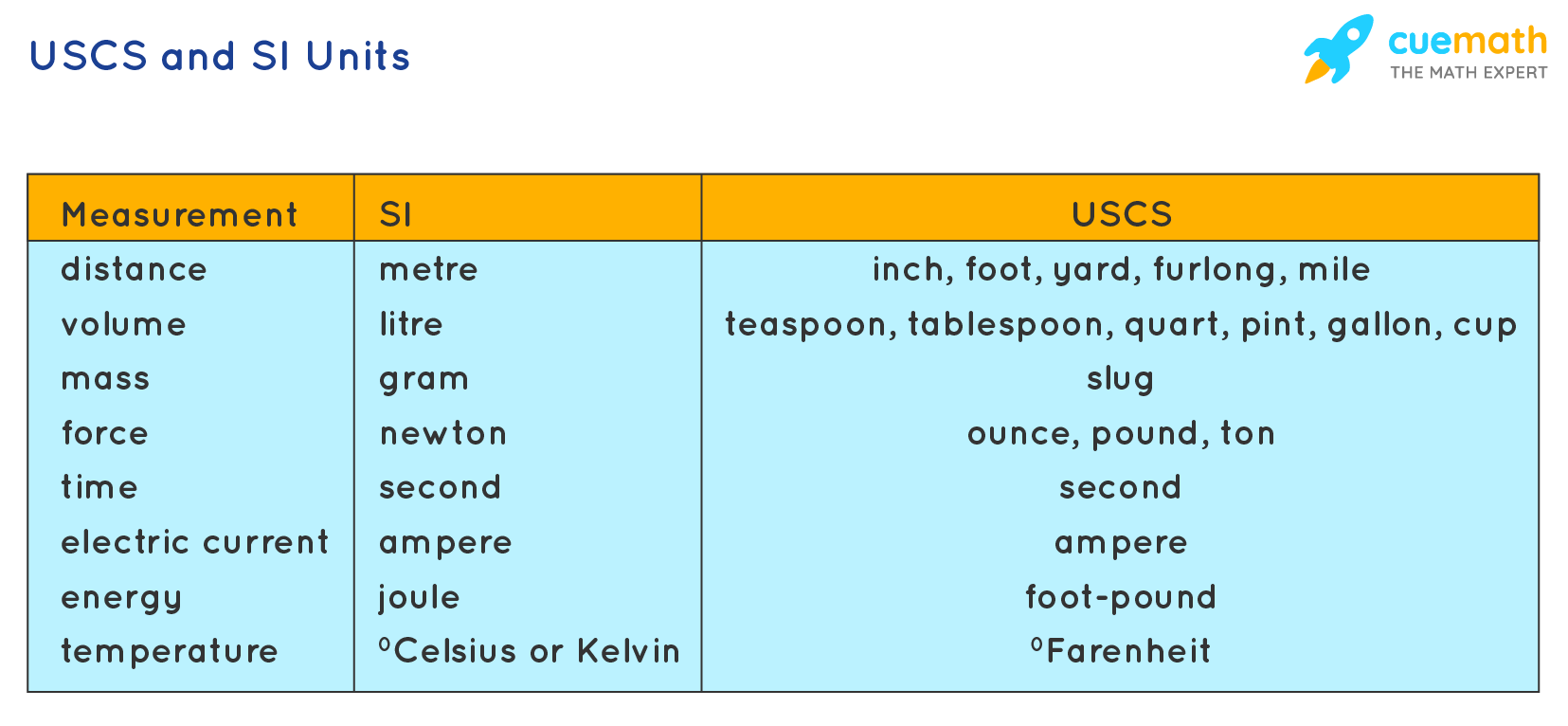 |
| Photo: Cuemath |
The USCS system evolved from the British Imperial system. The United States metric units are also called "imperial units." The main difference between the SI units and the American metric units is the terms and the type of units used. For instance, the length is measured using the meter in SI units whereas foot is used in the United States metric units. The following table shows the differences between SI units and USCS.
Origin of Metric System
Metrication is the process of implementing the International system of units (SI units). It was followed by almost all the countries except the United States, Myanmar, and Liberia. The United States then introduced its own customary units which are extensively used in various fields which is USCS. Thus, the metric units followed in the United States are called United States Customary Units (USCS).
Length, Weight, Capacity, and Time
Let us look briefly into the metric units that we use, along with a few examples:
Length
The unit length is used for measuring the size of an object or the distance from one end to the other end. There are various units such as a meter, kilometer, millimeter, feet, inches, and so on. The standard unit for measurement of length is meter. The standard tool we use to measure length is a ruler. These are some examples that show where the length measurements are typically used:
- This indicates there is a school at a 1-kilometer distance.
- The height of this door is about 6 feet.
- This paper clip is 1 inch long.
Length: Metric Conversion
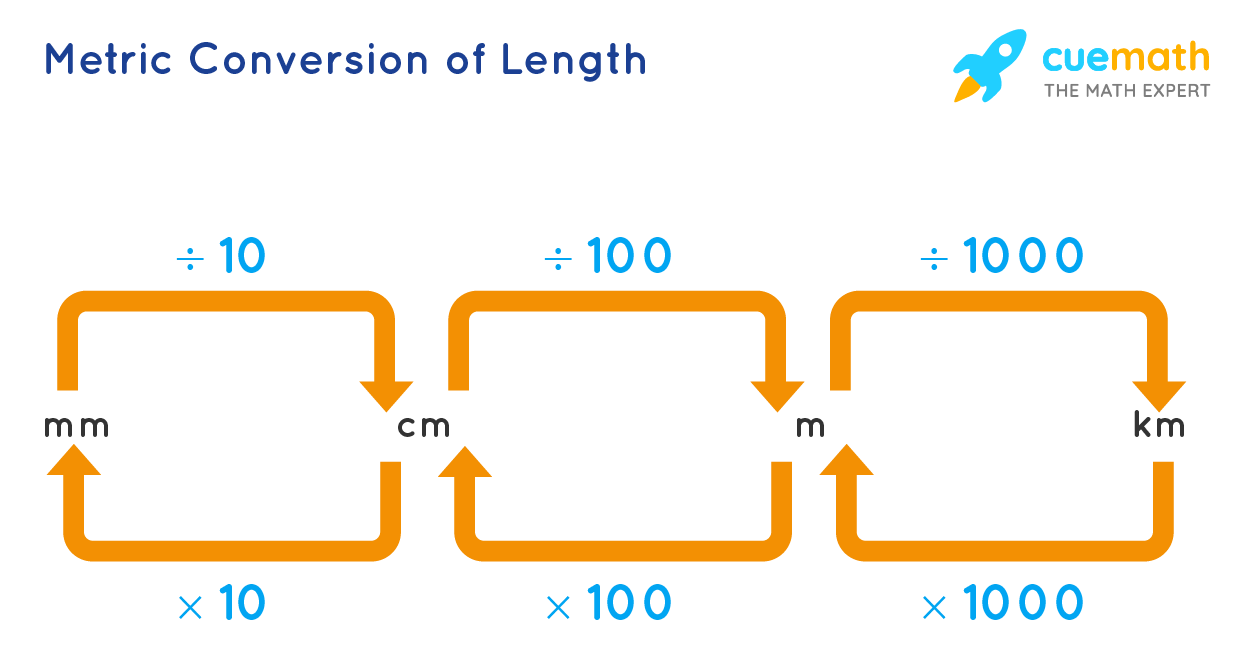 |
| Photo: Cuemath |
The kilometer is the largest unit and the millimeter is the smallest unit of measuring length.
The below table shows various units of length measurement with their respective conversions in the metric system.
| Unit | Approximate Value |
|---|---|
| 1 mile (mi) | 1.6 kilometer(km) |
| 1 inch (in) | 2.5 centimeter(cm) |
| 1 Foot (ft) | 30 cm |
Weight
The unit weight is used for measuring the mass of an object. The standard unit for measurement of weight is a kilogram. The standard tool we use to measure weight is the beam-balance or the weighing scale. These are some examples that show where the weight measurements are typically used:
- The weight of two bread slices is about 100 grams.
- The weight of a loaf of bread is about one kilogram (kg).
- An elephant weighs approx. about 5 tonnes.
Weight: Metric Conversion
 |
| Photo: Cuemath |
Capacity
The term capacity is used for measuring the volume or the space occupied by an object. The standard unit for measurement of capacity is the liter. The standard tool we use to measure length is the measuring cup. For example,
- A liter of milk.
- 500 ml of oil.
- A cup of coffee.
Capacity: Metric Conversion
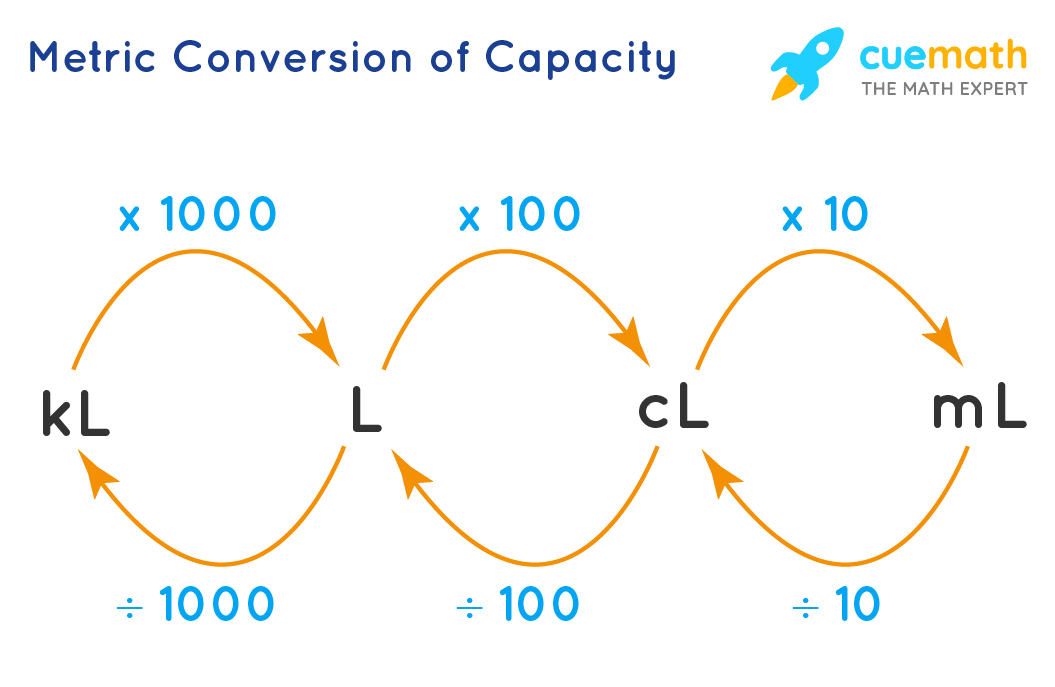 |
| Photo: Cuemath |
A liter of liquid water has a mass almost exactly equal to one kilogram at standard pressure.
| Unit | Value |
| 1 l | 1 kg |
| 1 cup | 250 ml |
| 1 l | 1000 ml |
Time
We do not need much introduction to the word "time" as we use it frequently. The measurement of time is common in both the SI units and the United States metric units. For example,
- Amiley answered the question in a fraction of a second.
- Julie took an hour to complete her homework.
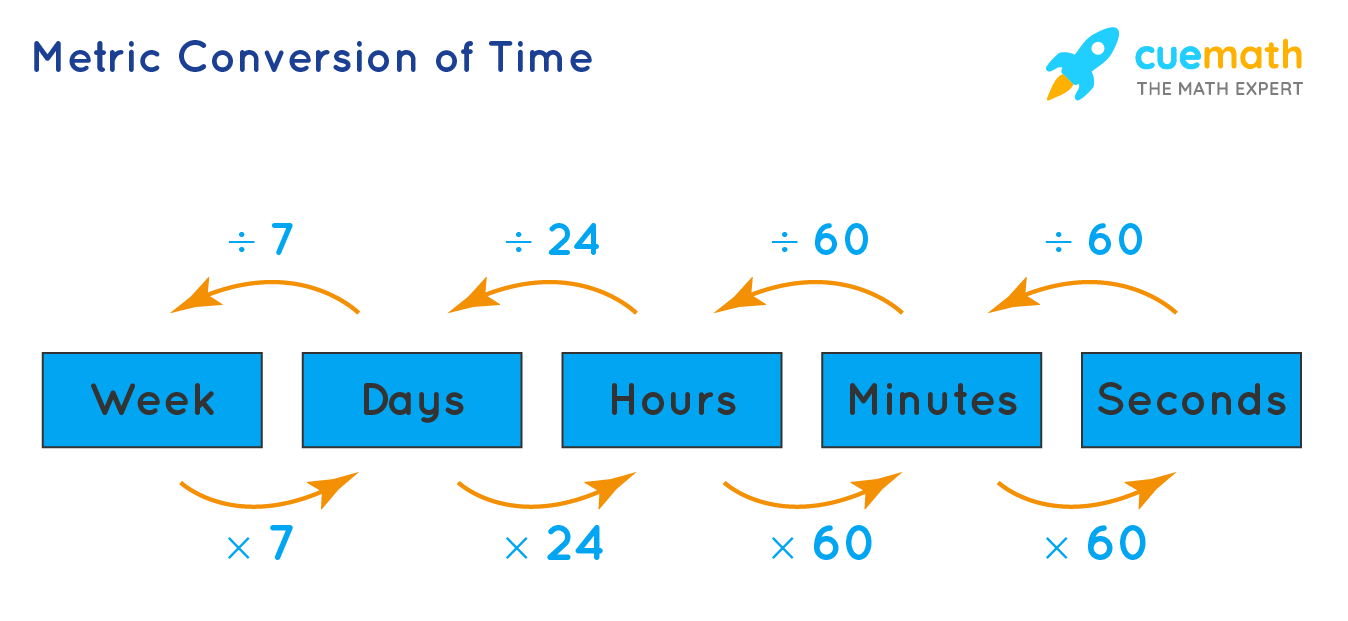 |
| Photo: Cuemath |
| Unit | Value |
|---|---|
| 1 minute | 60 seconds |
| 1 hour | 60 minutes |
| 1 day | 24 hours |
| 1 week | 7 days |
| 1 year | 365 days |
| 1 leap year | 366 days |
Important Notes on Metric System
Given below are a few important notes on the topic metric system that will help you in understanding the topic better and faster.
- The metric system consists of a set of units for measuring length, weight, capacity, temperature, etc.
- We follow the International System of Units (SI units).
- The standard unit for measurement of length is meter.
- The standard unit for measurement of weight is a kilogram.
- The standard unit for measurement of capacity is the liter.
- Time is measured using hours, minutes, and seconds.
How to convert units of measure in the same system
Imagine you are catering for a party and go to the wholesale shop to buy flour. You need 200 g of flour for each batch of cookies you will be making and need to make 30 batches. You can buy a 5 kg bag of flour but aren’t sure if that will be enough.
In order to work out if you have enough flour, you need both measurements to be in the same unit – kg or g – before you can do the calculation. For units of measure that are in the same system (so you are not dealing with converting cm and inches for example) it’s a simple process to convert one measurement into another.
For now we will focus on what is known as the metric system of measurement (we will look at some units from the imperial system later on in the session). In most cases, if you want to convert between units in the metric system you will just need to multiply or divide by 10, 100 or 1000.
Take a look at the diagrams below which explain how to convert each type of measurement unit.
Length
 |
| Figure 1 A conversion chart for length. Photo: open.edu |
Weight
 |
| Photo: open.edu |
Money
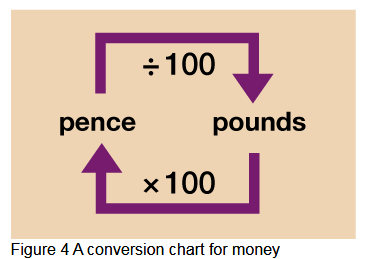 |
| Photo: Open.edu |
Capacity
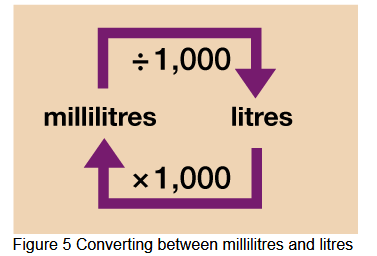 |
| Photo: open.edu |
 |
| Photo: open.edu |
| Note: Capacity may also be measured in centilitres (shortened to cl). On a standard bottle of water, for instance, it may give the capacity as 500 ml or 50 cl – there are 10 millilitres (ml) in 1 centilitre (cl). When converting between units you may need to do the conversion in stages. |
Example: Converting length
You measure the gap for a washing machine to be 0.62 m. You look on a retailer’s website and it shows the width of a particular washing machine to be 600 mm. Will this fit in the gap?
Method
You can convert the gap for the washing machine in stages. Convert from metres to centimetres first by multiplying by 100:
0.62 m × 100 = 62 cm
Now convert the centimetres figure into millimetres by multiplying by 10:
62 cm × 10 = 620 mm
So the washing machine (600 mm wide) will fit in the gap of 620 mm.
You may have preferred to convert the washing machine width into metres instead and do the comparison that way:
600 mm ÷ 10 = 60 cm
60 cm ÷ 100 = 0.6 m
0.6 m is less than 0.62 m so the washing machine will fit the gap.
Activity 2: Converting units
Use your conversion skills to fill in the missing information in Table 1(a). You may want to carry out some of the calculations in stages.
Please carry out all of your calculations without using a calculator. However, double-check on a calculator if you need to.
Table 1(a)
| Length | Weight | Capacity |
| 55cm = ? mm | 9.75 kg = ? g | 235 ml = ? l |
| 257 cm = ? m | 652 g = ? kg | 18.255 l = ? ml |
| 28.7 km = ? m | 5846 g = ? kg | 16 ml = ? l |
| 769 mm = ? cm | 19.4 kg = ? g | 7.88 l = ? ml |
| 1.43 m = ? mm | 44 g = ? mg | 250 ml = ? cl |
| 125 500 cm = ? km | 750 000 mg = ? kg | 7.4 l = ? cl |
Answer
Table 1(b)
| Length | Weight | Capacity |
| 55cm × 10 = 550 mm | 9.75 kg × 1000 = 9750 g | 235 ml ÷ 1000 = 0.235 l |
| 257 cm ÷ 100 = 2.57 m | 652 g ÷ 1000 = 0.652 kg | 18.255 l × 1000 = 18 225 ml |
| 28.7 km × 1000 = 28 700 m | 5846 g ÷ 1000 = 5.846 kg | 16 ml ÷ 1000 = 0.016 l |
| 769 mm ÷ 10 = 76.9 cm | 19.4 kg × 1000 = 19 400 g | 7.88 l × 1000 = 7880 ml |
| 1.43 m × 100 = 143 cm × 10 = 1430 mm | 44 g × 1000 = 44 000 mg | 250 ml ÷ 10 = 25 cl |
| 125 500 cm ÷ 100 = 1255 m ÷ 1000 = 1.255 km | 750 000 mg ÷ 1000 = 750 g ÷ 1000 = 0.75 kg | 7.4 l × 100 = 740 cl |
Unit Conversions with multiple conversion factors
Sometimes multiple conversions are needed before we end up with the units we want. For example, How many minutes are there in 2 days? The process is the same, we just repeat the steps for every unit conversion we make.
Steps for Unit Conversions
- Look at the units you have.
- Figure out the units you want.
- Find the conversion factors that will help you step by step get to the units you want.
- Arrange conversion factors so that unwanted units cancel out.
The following example shows how to use a basic conversion factor to fix non-SI units.
Dr. Geekmajor absentmindedly measures the mass of a sample to be 0.75 lb and records his measurement in his lab notebook. His astute lab assistant, who wants to save the doctor some embarrassment, knows that there are 2.2 lbs in every kilogram. The assistant quickly converts the doctor’s measurement to SI units. What does she get?
The answer is 0.34 kg.

Let’s try another example. A chemistry student, daydreaming during lab, suddenly looks down to find that he’s measured the volume of his sample to be 1.5 cubic inches. What does he get when he converts this quantity to cubic centimeters?
The answer is 25 cm3.

Rookie chemists often mistakenly assume that if there are 2.54 centimeters in every inch, then there are 2.54 cubic centimeters in every cubic inch. No! Although this assumption seems logical at first glance, it leads to catastrophically wrong answers. Remember that cubic units are units of volume and that the formula for volume is

Imagine 1 cubic inch as a cube with 1-inch sides. The cube’s volume is

Now consider the dimensions of the cube in centimeters:

Calculate the volume using these measurements, and you get

This volume is much greater than 2.54 cm3! To convert units of area or volume using length measurements, square or cube everything in your conversion factor, not just the units, and everything works out just fine.
Conversion factor table
The following table includes some useful conversion factors.

How to convert between units using a Windows 10 PC
To convert units on Windows 10, open the Calculator app, click the hamburger icon in the top-left and choose the conversion type to use.
Need to convert between units? There's no need to head to the internet while working on your PC. Instead, open Windows 10's Calculator app to use the built-in quick conversion features.
With Windows 10, Microsoft made Calculator into far more than a simple arithmetic tool. Click the hamburger icon in the top-left to switch between the calculator's modes.
 |
| Photo: OnMSTF |
The options available are comprehensive - whether you're looking for length, weight, temperature or even currency, Calculator has you covered. There's even options for converting units of time, power and data.
 |
| Photo: OnMSTF |
Chances are that you'll be able to use Calculator to convert between any commonly used sets of units. Select the appropriate category and then enter your two values. You can change the selected units using the dropdowns below the value.
With this example, we're converting miles per hour into kilometres per hour. We can also see the result if we convert into nautical knots, or even aeronautical mach units.
Calculator automatically remembers your last used conversion category. Next time you use the app, it will return you into that section. Expand the hamburger menu and click the "Standard" option at the top to return to the regular mathematical calendar.
Best Unit Converter Apps for Android & iOS
How painful it is to know all units and their conversions by heart not mentioning the converting itself. Exchange your money while traveling; check school mathematical tasks; make some calculations for a major project… You will need a digital helper – units converter app.
Why apps for unit converting is necessary? First of all, they save time dramatically. Secondly, they a more accurate and will never make even a minor mistake that may cause dramatic consequences. Finally, they will keep you on top of things in the world of never-stable currencies.
ConvertPad
ConvertPad is the most complete unit converter. It has a variety of different units of measurement from length and speed to clothing sizes and TOEFL Scores as well as currencies.
It is also possible to customize and feature your own units by inserting its name and the function for necessary calculations.
You can also do basic mathematical computations right in this app because it includes a calculator.
Convert Units for free
A powerful analog for iOS is Convert Units. It is intuitive and includes a lot of units of diverse types, so it will go for professional and habitual purposes.
You may set several more not listed units for converting. Any of your calculations may be saved to have quick access to what you have already counted. And the biggest merit of this app is that it is free.
Units – Free Unit Converter
A user-friendly app created for iOS Units will also a great choice. All units set in are combined in a scroll, so it is very convenient. The app also saves all your results to enable you to search quickly all figures that you need.
What special about it is that it includes a built-in ruler that may be used at any time to take little and swift measurements.
Super Unit Converter
If you don’t want to overload your app with unneeded units, Super Unit Converter will help you to design the array of them yourself. You just have to choose the number of units in settings that should be shown in your scroll.
A long list of units is standard but it doesn’t include an option for creating your own one. So, if you don’t need any sophisticating additional things, this app will suit your needs amply.
 How to Convert .Numbers to .Excel: Top 3 Best Tips How to Convert .Numbers to .Excel: Top 3 Best Tips How to Convert .Numbers to .Excel: We have three useful tips for you! |
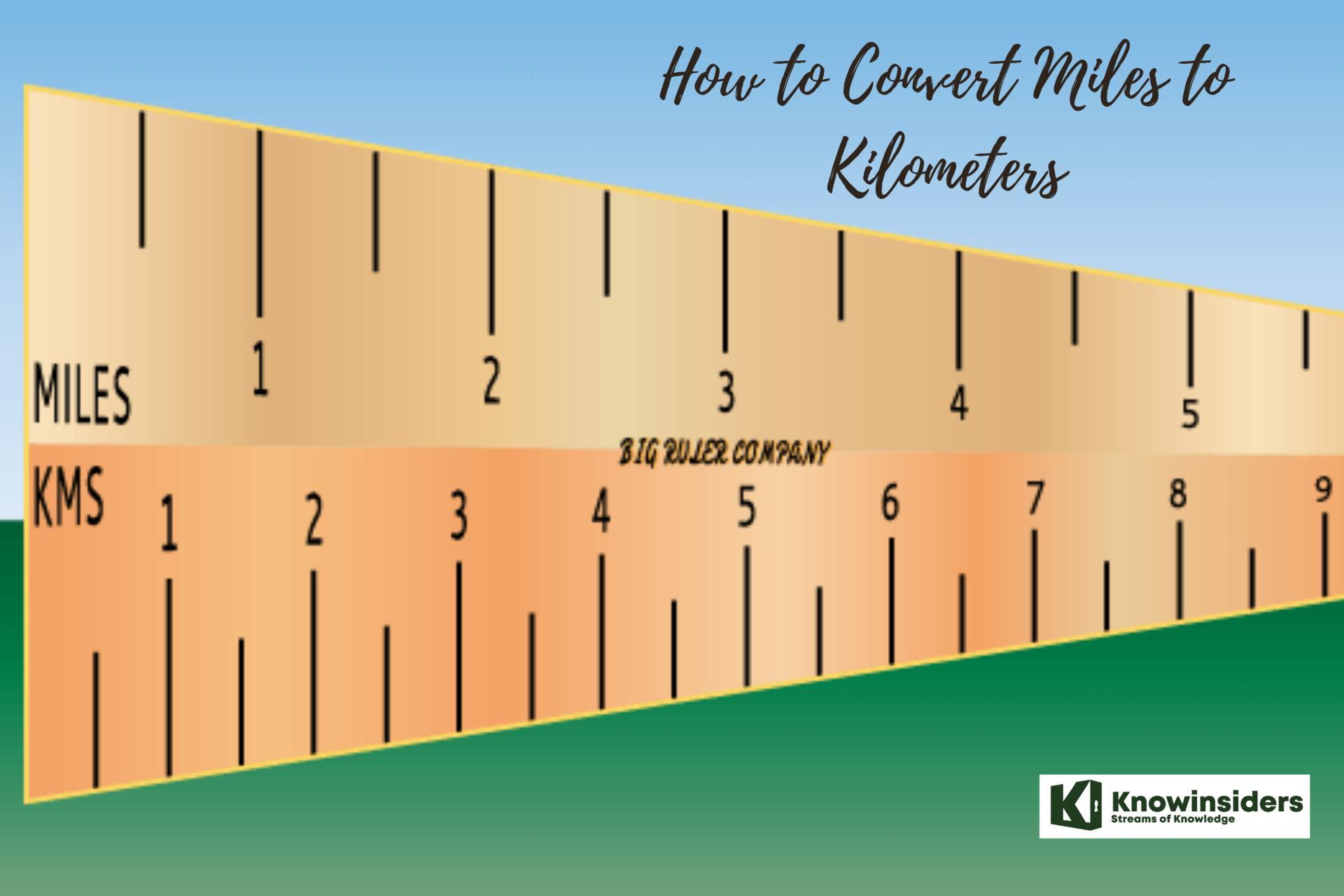 How to Convert Miles to Kilometers: Simple Ways to Change How to Convert Miles to Kilometers: Simple Ways to Change Kilometer and Mile are two popular units of length that are used worldwide. Check out the way to convert Miles to Kilometers right below! |
 How to Convert Kilometers to Miles: Best Ways to Change How to Convert Kilometers to Miles: Best Ways to Change Kilometers and Miles are both used to describe distance in real life. Check out the methods to convert Kilometers to Miles right below! |


























